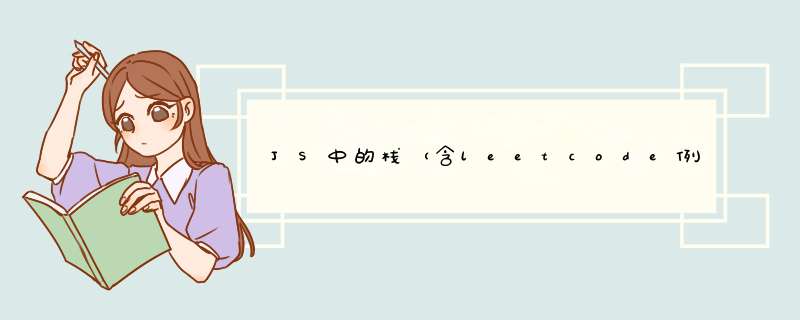
先进后出
实现方式 基于数组实现 // 封装栈类
function Stack(){
// 栈的属性
this.items = []
// 栈的相关 *** 作
// 1.push压栈
Stack.prototype.push = function(element){
return this.items.push(element)
}
// 2.pop出栈
Stack.prototype.pop = function(){
return this.items.pop()
}
// 3.peek查看栈顶
Stack.prototype.peek = function(){
return this.items[this.items.length - 1]
}
// 4.isEmpty判断栈是否为空
Stack.prototype.isEmpty = function(){
return this.items.length == 0
}
// 5.size获取个数
Stack.prototype.size = function(){
return this.items.length
}
// 6.toString转为字符串
Stack.prototype.toString = function(){
let res = ''
for(let i =0;i<this.items.length;i++){
res += this.items[i]+','
}
return res
}
}
// 7.getMin获取最小值
Stack.prototype.toString = function(){
var min = this.item[0]
for(var i = 1 ;i<this.item.length ; i++){
if(this.item[i]<min){
min = this.item[i]
}
}
return min
}
// 栈的使用
var s = new Stack()
待补充
leetcode例题 20.字符串括号匹配
**
* @param {string} s
* @return {boolean}
*/
var isValid = function(s) {
var isMatch = function(left,right){
if(left==='(' && right===')') return true
if(left==='[' && right===']') return true
if(left==='{' && right==='}') return true
return false
}
const stack = []
const leftMoudle = "([{"
const rightMoudle = "}])"
for(let i = 0 ; i < s.length ; i++){
if(leftMoudle.includes(s[i])){
stack.push(s[i])
}else if(rightMoudle.includes(s[i])){
if(isMatch(stack[stack.length-1],s[i])){
stack.pop()
}else{
return false
}
}
}
if(stack.length === 0){
return true
}else{
return false
}
};
// 求最小值的主要思路是
// 创建另一个min_stack只用来比较当前push的最小值和min_stack的栈顶
// 谁小就把谁push进去
// 最后的最小值就是栈顶
var MinStack = function() {
this.item = []
this.min_stack = [Infinity]
};
/**
* @param {number} val
* @return {void}
*/
MinStack.prototype.push = function(val) {
if(val<this.min_stack[this.min_stack.length-1]){
this.min_stack.push(val)
}else{
this.min_stack.push(this.min_stack[this.min_stack.length-1])
}
return this.item.push(val)
};
/**
* @return {void}
*/
MinStack.prototype.pop = function() {
this.min_stack.pop()
return this.item.pop()
};
/**
* @return {number}
*/
MinStack.prototype.top = function() {
return this.item[this.item.length-1]
};
/**
* @return {number}
*/
MinStack.prototype.getMin = function() {
return this.min_stack[this.min_stack.length-1]
};
// stack1为主栈,代表队列
// stack2辅助
// push功能直接加在stack1
// pop:
// 1.先将stack1出栈,再入栈到stack2中,这样就实现了逆置,再pop掉stack2,实现删除第一个元素。
// 2.此时要注意,删除第一个元素后要再进行一遍将stack2逆置给stack1的 *** 作,避免中间有push使得顺序错乱。
var MyQueue = function() {
this.stack1 = []
this.stack2 = []
};
/**
* @param {number} x
* @return {void}
*/
MyQueue.prototype.push = function(x) {
this.stack1.push(x)
};
/**
* @return {number}
*/
MyQueue.prototype.pop = function() {
while(this.stack1.length){
let n = this.stack1.pop()
this.stack2.push(n)
}
const res = this.stack2.pop()
while(this.stack2.length){
let n = this.stack2.pop()
this.stack1.push(n)
}
return res
};
/**
* @return {number}
*/
MyQueue.prototype.peek = function() {
return this.stack1[0]
};
/**
* @return {boolean}
*/
MyQueue.prototype.empty = function() {
if(this.stack1[0]){
return false
}else{
return true
}
};
当然,这种方式复杂度太高,需要优化
496.下一个更大元素var nextGreaterElement = function(nums1, nums2) {
// Map + Stack
let map = new Map()
let stack = []
let res = []
// 遍历nums2,找到每一个元素的下一个最大元素
// 思路为:循环的元素大于栈顶元素,且栈不为空,即找到下一个最大值,将栈顶元素作为key,下一个作为value
// 存入map,将栈顶元素pop
nums2.forEach(item=>{
while(stack.length && item>stack[stack.length-1]){
map.set(stack.pop(),item)
}
stack.push(item)
})
// 剩余元素没有下一个最大值,value为-1
stack.forEach(item=>map.set(item,-1))
// 遍历nums1,将符合要求的push到结果中
nums1.forEach(item=>res.push(map.get(item)))
return res
};
之后leetcode中遇到求一个更大元素类型的题都是使用map+stack
欢迎分享,转载请注明来源:内存溢出

 微信扫一扫
微信扫一扫
 支付宝扫一扫
支付宝扫一扫
评论列表(0条)